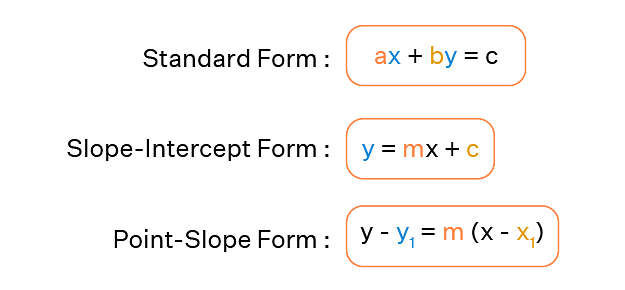The hypotenuse of a right-angled triangle has its ends at the points (1, 3) and (-4, 1). Find the equation of the legs (perpendicular sides) of the triangle.
Solution and Explanation
Let A(1,3) and B(-4,1) be the coordinates of the end points of the hypotenuse. Now, plotting the line segment joining the points A(1,3) and B(-4,1) on the coordinate plane, we will get two right triangles with AB as the hypotenuse. Now from the diagram, it is clear that the point of intersection of the other two legs of the right triangle having AB as the hypotenuse can be either P or Q.

CASE 1: When \(∠ APB\) is taken. The perpendicular sides in \(∠ APB\) are AP and PB.
Now, side PB is parallel to x-axis and at a distance of 1 units above x-axis.
So, equation of PB is, y=1 or y-1=0.
The side AP is parallel to y-axis and at a distance of 1 units on the right of y-axis.
So, equation of AP is x=1 or x-1=0.
CASE 2: When \(∠ AQB\) is taken. The perpendicular sides in \(∠ AQB \) are AQ and QB.
Now, side AQ is parallel to x-axis and at a distance of 3 units above x-axis.
So, equation of AQ is, y=3 or y-3=0.
The side QB is parallel to y-axis and at a distance of 4 units on the left of y-axis.
So, equation of QB is x=-4 or x+4=0.
Hence, the equation of the legs are : x=1, y=1 or x=-4, y=3
Top Questions on Straight lines
- The equation of a straight line is given by \( y = 3x + 4 \). What is the slope of the line?
- BITSAT - 2025
- Mathematics
- Straight lines
- Find the slope of the line passing through the points $ (1, 2) $ and $ (3, 6) $:
- BITSAT - 2025
- Mathematics
- Straight lines
- The equation of the line passing through the point \((1, 2)\) and perpendicular to the line \(3x + 4y - 12 = 0\) is:
- AP EAPCET - 2025
- Mathematics
- Straight lines
- Find the slope of the line perpendicular to the line $ 3x + 4y - 12 = 0 $.
- AP EAPCET - 2025
- Mathematics
- Straight lines
- The maximum area of a right-angled triangle with hypotenuse \( h \) is: (a) \( \frac{h^2}{2\sqrt{2}} \)
- VITEEE - 2024
- Mathematics
- Straight lines
Questions Asked in CBSE Class XI exam
- \(\text{tan x}=-\frac{4}{3},\text{x\, in\, quadrant \,II.}\)
- CBSE Class XI
- Trigonometric Functions of Sum and Difference of Two Angles
- If the function f(x) satisfies \(\lim_{x\rightarrow 1}\) \(\frac{f(x)-2}{x^2-1}\) =\(\pi\), evaluate \(\lim_{x\rightarrow 1}\) f(x).
- \(∆U^Θ\) of combustion of methane is – \(X\ kJ \ mol^{–1}\). The value of \(∆H^Θ\) is
- CBSE Class XI
- Thermodynamics terms
- Write the resonance structures for SO3 , NO2 and NO3-
- CBSE Class XI
- Kossel-Lewis Approach to Chemical Bonding
- Three reasons why the author’s grandmother was disturbed when he started going to the city school.
- CBSE Class XI
- The Portrait of a lady
Concepts Used:
Straight lines
A straight line is a line having the shortest distance between two points.
A straight line can be represented as an equation in various forms, as show in the image below:

The following are the many forms of the equation of the line that are presented in straight line-
1. Slope – Point Form
Assume P0(x0, y0) is a fixed point on a non-vertical line L with m as its slope. If P (x, y) is an arbitrary point on L, then the point (x, y) lies on the line with slope m through the fixed point (x0, y0) if and only if its coordinates fulfil the equation below.
y – y0 = m (x – x0)
2. Two – Point Form
Let's look at the line. L crosses between two places. P1(x1, y1) and P2(x2, y2) are general points on L, while P (x, y) is a general point on L. As a result, the three points P1, P2, and P are collinear, and it becomes
The slope of P2P = The slope of P1P2 , i.e.
\(\frac{y-y_1}{x-x_1} = \frac{y_2-y_1}{x_2-x_1}\)
Hence, the equation becomes:
y - y1 =\( \frac{y_2-y_1}{x_2-x_1} (x-x1)\)
3. Slope-Intercept Form
Assume that a line L with slope m intersects the y-axis at a distance c from the origin, and that the distance c is referred to as the line L's y-intercept. As a result, the coordinates of the spot on the y-axis where the line intersects are (0, c). As a result, the slope of the line L is m, and it passes through a fixed point (0, c). The equation of the line L thus obtained from the slope – point form is given by
y – c =m( x - 0 )
As a result, the point (x, y) on the line with slope m and y-intercept c lies on the line, if and only if
y = m x +c